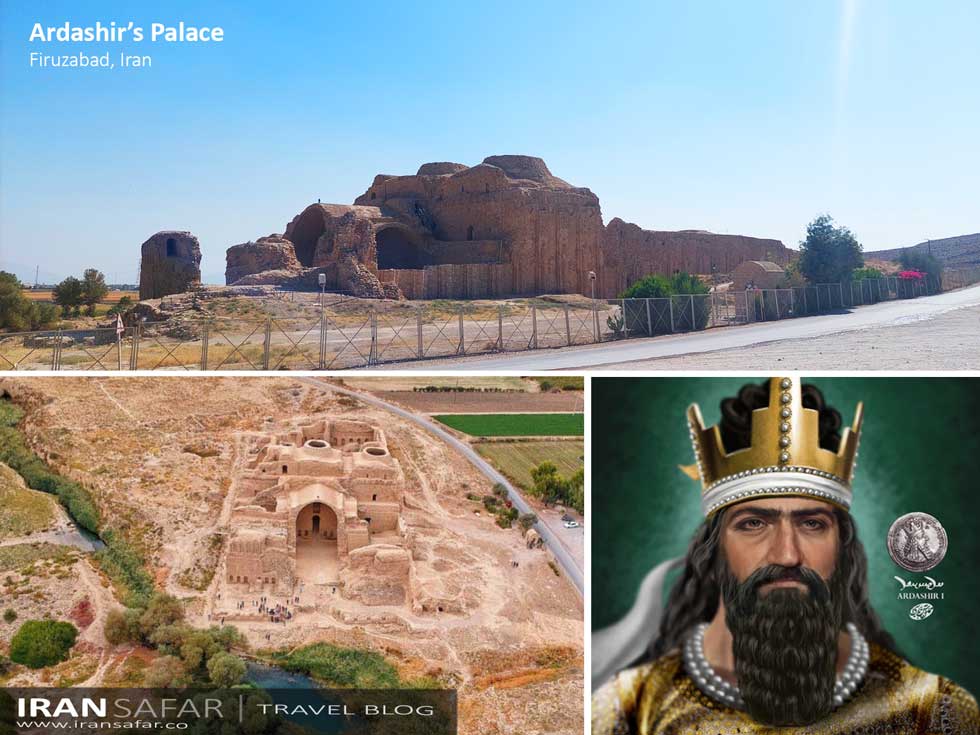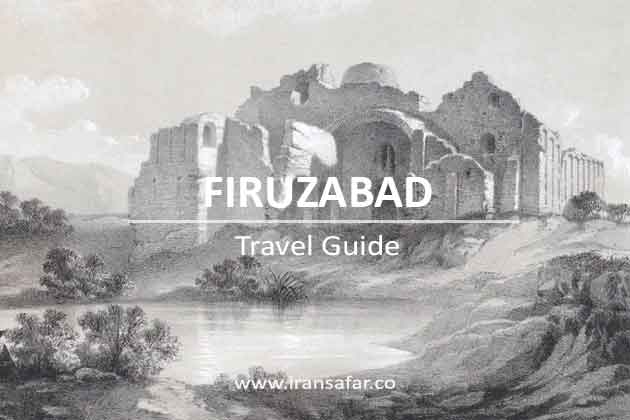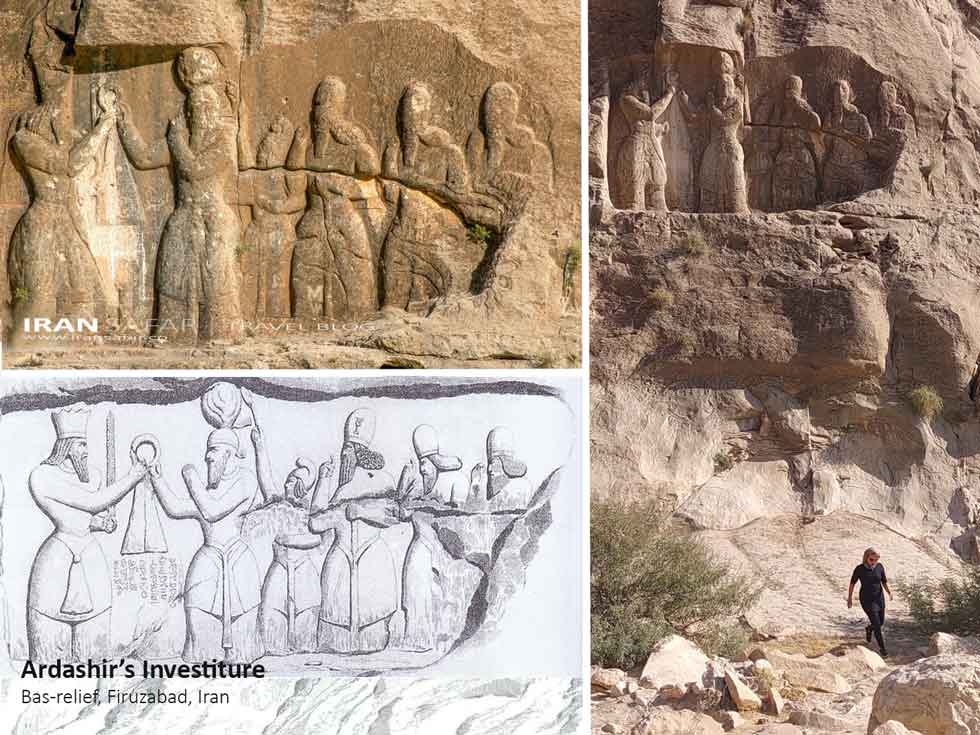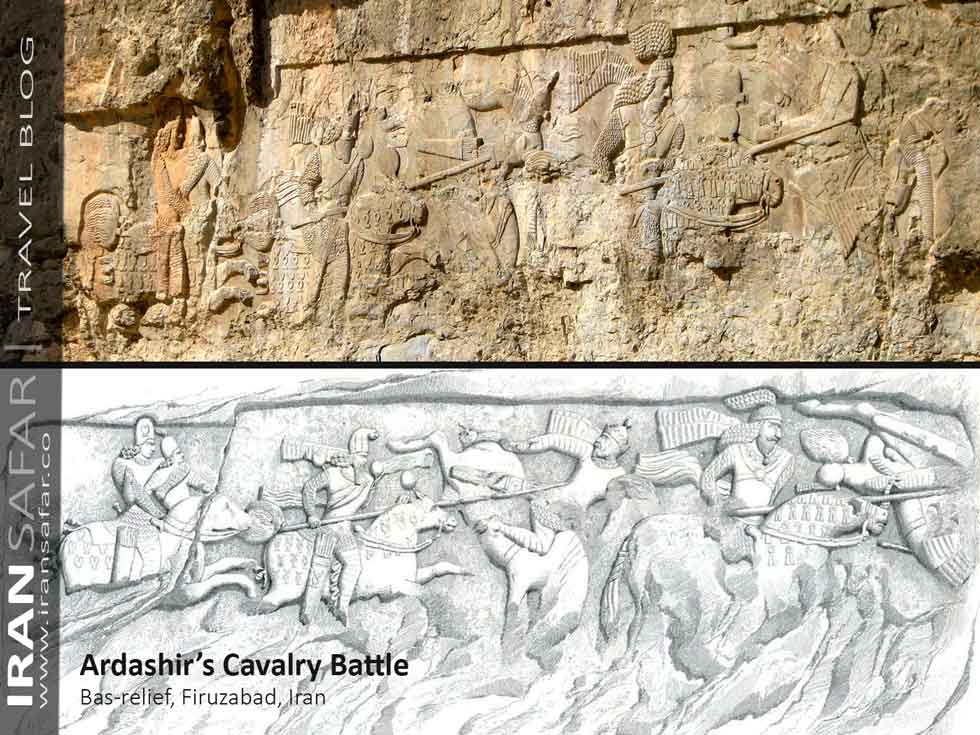Fīrūzābād is located 96 km south of Shiraz and 3 km from the ancient site of Gor. The history of this city dates back to the Achaemenid period, but the peak of its fame and its surviving works were related to the Sassanid era . The city of Firuzabad is mentioned in the ancient history of Iran with the names of Gōr , Jōr , and Ardashir kharraw. This city has a population of about 65,000 people.
 The palace of Ardashir, Firuzabad, Iran
The palace of Ardashir, Firuzabad, Iran
Firuzabad Ancient City – Overview
The modern city of Firuzabad was built on top of the remains of the ancient city of Gōr. According to history, Gōr goes way back to the time of the Achaemenid Empire. It met its end when Alexander the Great came along. Later on, Ardashir I, also known as Ardashir Babakan, founded the Sasanian Empire (224-651 AD), and gave Gōr a new lease on life, but it got sacked during the Arab Muslim invasion in the 7th century. The Buyids, led by king Azod Al-Dawla, tried to revive it, but it eventually faded away during the 19th century when the Qajar dynasty took over. A nearby new town also called Firuzabad took its place.
Ardashir I Sassanid
Ardashir I, often referred to as Ardashir the Unifier, or Ardashir Babakan lived from 180 to 242 AD. He holds the distinction of being the founder of the mighty Persian Sasanian Empire. He originally bore the title Ardashir V within the line of Kings of Persis until he decided to establish a new empire. In a pivotal moment, Ardashir defeated the final Parthian ruler, Artabanus IV, on the plains of Hormozdgan in 224 AD. This triumph marked the end of the Parthian dynasty and the rise of the Sasanian dynasty. Following this significant victory, Ardashir adopted the title “shahanshah” and embarked on a series of conquests, with the aim of uniting the land that he designated as Iran.
Firozabad is a place where you’ll find a mix of people with different ethnic backgrounds. Majority of the locals in Firuzabad are native Persian speakers, and they have a dialect that’s pretty close to Tajik. You’ll also come across a bunch of folks from various tribes who speak Lori, or Qashqai Turkish dialect who have settled here more recently. The occupation of most people in this city is agriculture.
Because of its strategic location along the route to the Persian Gulf and the southern ports of Iran, Firuzabad experienced an economic boom. As a result, numerous recreational and commercial projects are currently in progress in the city.
Also Read : Naqsh-e Rostam | Site map, History, Information & Facts
Circular City of Gor
The old city had a unique design. It was perfectly circular, measuring 1,950 meters in diameter. Inside, it was divided into twenty sections using a precise geometric layout of twenty straight streets radiating from the center, along with several rings of streets. The city was well protected by a sturdy main wall made of compacted clay, a wide 35-meter ditch, and an outer wall. Inside the city, there was another wall that marked off the central circular area, likely where important government buildings were located.
Also Read : Taq-e Bostan | a legacy of Sassanids
History of Firuzabad
The foundation of the city is often credited to Ardashir I in most historical records. It’s pretty clear that associating its foundation with King Piruz Sassanid is more of a guess, based on its later name, Piruz Abad.
Although some accounts might suggest that the town was established after Ardashir’s victory over Ardavan IV (also known as ARTABANUS IV), the evidence from archaeology and architectural history tells a different story. It confirms the accuracy of Ṭabarī‘s account, which places the city’s founding before the decisive battle, during Ardašīr’s quest for power.
The plain of Firuzabad has been inhabited since prehistoric eras. There’s this significant Chalcolithic site down in the south known as Toll-e Rigi. The place is surrounded by the steep Zagros mountains, and there are only a few access roads that lead in, making it easy to defend. It’s the spot that Ardashir I chose as his main stronghold when he rebelled against the last Parthian King. His construction projects in the area left a lasting mark, showcasing early Sasanian architectural planning. He even founded a city here, which he called Ardashir-Khwarrah, meaning “Glory of Ardashir.” This move was a big challenge to Parthian royal authority and eventually led to a showdown with Artabanus in 224 C.E.
The name Fīrūzābād was bestowed by a Buyid king Azod-al-Dawla in the 10th century, replacing the ancient names of Gōr (Jūr) and Ardashir-Khwarrah. The rich literary tradition about the place pays special attention to the period of the downfall of the Parthians and the emergence of the Sasanian empire in the early 3rd century C.E.
After the introduction of Islam in Iran, one of Firuzabad’s notable heydays can be linked to the rule of the Buyid Dynasty (934-1062 AD) They set up their power center in Shiraz, and during this time, Firuzabad flourished with the establishment of a mosque, a hospital, and even a library.
However, by the 12th century, the old Firuzabad was deserted. In the following eras, a village named Koushk sprang up outside the city, which eventually grew into the present-day city of Firuzabad. Within this area, you’d find Haj Emad al-Molk’s mansion, a small castle, and a bustling market, all of which played significant roles in the village’s life until the Qajar period.
Also Read: Sassanid Archaeological Landscape of Fars
What to see at Firuzabad?
Walking alongside these walls, you can’t help but feel like a time traveler. The ancient stones whisper stories of battles and triumphs, of kings and commoners. It’s a journey that offers an unparalleled connection to the past.
1
Qal’eh Dokhtar: The Maiden Castle
One of the most iconic landmarks near the ancient city of Firuzabad is the Qal’eh Dokhtar, which translates to the “Maiden Castle.” Perched on a hill, this fortress provides a breathtaking panoramic view of the city. The mere sight of this architectural marvel will leave you awe-struck.
Qal’eh Dokhtar, which was evidently Ardashir’s initial dwelling and stronghold, was constructed simultaneously with the circular city of Ardashir Kharraw. It’s a grand palace within a substantial fortification, perched on a mountain plateau overlooking a bend of the Tang-āb river, strategically guarding the primary entry to the plain.
Name Derivation
The name of this castle may be due to its attribution to the goddess Anahita, who is imagined as a maiden in ancient Iranian culture.
Another possibility is that because this castle was unattainable and was never conquered over time, it became known as the Maiden Castle.
The key rooms of the main palace were situated within a circular keep, standing as another symbol of the architectural design. However, this nearly impregnable location, chosen for its strategic advantage, combined with structural issues that may have arisen during construction due to innovative vaulting techniques, led to the early abandonment of this castle. Instead, a larger palace was built near a spring-fed pond at the gorge’s exit; Ardashir’s Palace, now erroneously called Ātaškada meaning the Fire Temple.
Also Read: Famous Castles of Iran
2
The Palace of Ardashir: Regal Elegance
In the heart of Firuzabad lies the Ardashir’s Palace, a place that redefines regal elegance. Its design, characterized by grand domes and exquisite carvings, speaks volumes about the opulence and grandeur of the Sassanid dynasty.
This newer palace, being less structurally ambitious and more robust, clearly indicates its construction at a later stage. It lacked the fortifications seen in the earlier palace and had a more imposing layout, suggesting it was built after Ardašīr had solidified his rule, and military concerns were no longer paramount. Both palaces share a similar architectural plan, albeit with some variations: grand reception halls with ayvāns (open-sided halls) and square domed chambers, measuring 14 meters in width, for royal audiences; barrel-vaulted rectangular halls surrounding a courtyard, likely used for royal court activities; and upper-level rooms for private living spaces.
Walking through the palace’s intricate chambers, you can’t help but imagine the lives of the rulers who once resided here. The Ardeshir Palace provides a fascinating window into the daily lives of the Sassanid kings.
3
The Mysterious Bas-Reliefs of Firuzabad
The Tang-āb gorge, situated just north of Qalʿeh Doḵtar, is home to two rock reliefs of Ardeshir and the remnants of a bridge associated with the 5th-century official Mehr-Narseh, as indicated by a Pahlavi inscription. These carvings are considered some of the best off-the-beaten-path places in Iran:
I
Ardashir’s Investiture: In the coronation or investiture relief in Firuzabad, we see and king Ardashir positioned face to face. Ahuramazda hands Ardashir the royal ring (Deyhim)from the fire altar, officially appointing him as king. Behind Ardashir, we can spot the Crown Prince Shapur I and two other princes. The dimensions of this artwork are impressive, measuring 7 meters in height and 3.70 meters in width. The motifs in the relief are meticulously crafted, displaying a profile view.
II
The Cavalry Battle relief: This carving illustrates the epic clash between Ardeshir Babakan, the founding figure of the Sassanid Empire, and Artabanus IV (Pers: Ardavan IV) the last Parthian king, in the year 224 AD. This historical gem is etched into the rock wall of the Tang-ab gorge, and you can catch a glimpse of it while journeying from Firuzabad to the ancient city of Gor. This remarkable relief, measuring a generous 18 meters in length and 4 meters in height, stands as the largest bas-relief from ancient Persia.
In this battle scene, six horseback warriors engage in fierce combat, facing off two by two. On the right, we witness Ardeshir Babakan, armed with a spear. In the center of the scene, Shapur, Ardeshir’s son, launches an attack on Dadband, Ardavan’s chief minister. The final figures of the battle scene are a Parthian knight and a Sassanid nobleman meeting their fates with a fight.
This artwork showcases the finesse and artistic flair of Persian craftsmen, portraying an array of intricate details. These include the weaponry used in battle, the unique hairstyles and beards of the individuals, and the decorative elements adorning the horses.
Read : History of Iran
Ancient City of Firuzabad – FAQs
Q: What is the significance of The Ancient City of Firuzabad?
A: The city holds immense historical and architectural importance, offering a glimpse into the Sassanid Empire’s grandeur and creativity.
Q: How can I reach Firuzabad?
A: Firuzabad is accessible by road and is located in the Fars Province of Iran, making it a must-visit destination for travelers. It is about 100 km from Shiraz. Check on Map
Q: What is the best time to visit Firuzabad?
A: The ideal time to visit Firuzabad is during the spring or fall when the weather is pleasant, and you can explore the sites comfortably.
Q: Are there guided tours available in Firuzabad?
A: No, there is no guide on the sites but you can contact us in advance to provide you with guided tours that enhance your experience by in-depth insights into the city’s history and architecture.
Q: What are some other attractions near Firuzabad?
A: Firuzabad’s vicinity is rich in historical sites, including Bishapur and Sarvestan Palace, making it a hub for history enthusiasts.
Q: Is Firuzabad easily accessible for international tourists?
A: Yes, international tourists can visit Firuzabad, and there are accommodations and services to make their stay comfortable and enjoyable.





Comment (0)